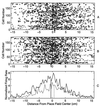Experience-dependent, asymmetric expansion of hippocampal place fields
- PMID: 9238078
- PMCID: PMC23195
- DOI: 10.1073/pnas.94.16.8918
Experience-dependent, asymmetric expansion of hippocampal place fields
Abstract
Theories of sequence learning based on temporally asymmetric, Hebbian long-term potentiation predict that during route learning the spatial firing distributions of hippocampal neurons should enlarge in a direction opposite to the animal's movement. On a route AB, increased synaptic drive from cells representing A would cause cells representing B to fire earlier and more robustly. These effects appeared within a few laps in rats running on closed tracks. This provides indirect evidence for Hebbian synaptic plasticity and a functional explanation for why place cells become directionally selective during route following, namely, to preserve the synaptic asymmetry necessary to encode the sequence direction.
Figures



References
-
- O’Keefe J, Dostrovsky J. Brain Res. 1971;34:171–175. - PubMed
-
- Hebb D O. The Organization of Behavior. New York: Wiley; 1949.
-
- Levy W B. In: Computational Models of Learning in Simple Neural Systems. Hawkins R D, Bower G H, editors. New York: Academic; 1989. pp. 243–305.
-
- Blum K, Abbott L. Int J Neural Syst. 1995;6:25–32.
-
- Abbott L, Blum K. Cereb Cortex. 1996;6:406–416. - PubMed
Publication types
MeSH terms
Grants and funding
LinkOut - more resources
Full Text Sources
Other Literature Sources

